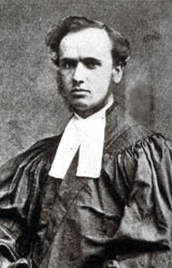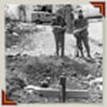Then and Now

When Alliance founder A. B. Simpson left a lucrative pastorate in New York City, he had a call from God to reach the lost masses both in New York and around the world.
Prostitutes, longshoremen, and the homeless received the reconciliation message that all people are eligible for Christ’s amazing grace. He established the New York Gospel Tabernacle to bring likeminded people together into an organization that could facilitate outreach ministries.
He set up the Missionary Training Institute (MTI) to provide training and resources for men and women God was calling to take the gospel to the world. During that time, Simpson’s group sent out the first team of missionaries to the Congo in 1884.
Since then, thousands of people have followed God’s call to serve through The Alliance in the United States and abroad. In 1974, The Christian and Missionary (C&MA) officially became a denomination, but it still had at its core a heart for overseas missions. Past Alliance president Dr. L. L. King said of the C&MA that it “was not established as a mission divorced from the normal activity of a church, but a church which had within it the life and function of a mission…. The mission came first and the church grew out of a mission.”
Today, the C&MA focuses on planting churches in the United States and overseas. Alliance international workers minister among the least reached peoples planting churches and training national church leaders, providing relief and development assistance, medical and dental care, and microenterprise projects. More than 2,000 churches in the U.S. minister Christ’s love to their communities and cities.
Prostitutes, longshoremen, and the homeless received the reconciliation message that all people are eligible for Christ’s amazing grace. He established the New York Gospel Tabernacle to bring likeminded people together into an organization that could facilitate outreach ministries.
He set up the Missionary Training Institute (MTI) to provide training and resources for men and women God was calling to take the gospel to the world. During that time, Simpson’s group sent out the first team of missionaries to the Congo in 1884.
Since then, thousands of people have followed God’s call to serve through The Alliance in the United States and abroad. In 1974, The Christian and Missionary (C&MA) officially became a denomination, but it still had at its core a heart for overseas missions. Past Alliance president Dr. L. L. King said of the C&MA that it “was not established as a mission divorced from the normal activity of a church, but a church which had within it the life and function of a mission…. The mission came first and the church grew out of a mission.”
Today, the C&MA focuses on planting churches in the United States and overseas. Alliance international workers minister among the least reached peoples planting churches and training national church leaders, providing relief and development assistance, medical and dental care, and microenterprise projects. More than 2,000 churches in the U.S. minister Christ’s love to their communities and cities.
The Founding Years (1887-1919)

The C&MA grew out of the vision of Rev. A.B. Simpson, a Presbyterian pastor from Canada. Simpson believed that Christ was not only his Savior, but also his Sanctifier, and Healer, and Coming King through dramatic spiritual encounters that changed the direction of his life. Formed as a missionary society and not a denomination, early Alliance congregations were known as “branches” and were made up of members from most major denominations. Find out more about those early years where the movement began.
Sacrifice and Expansion (1919-1946)

After Simpson’s death in 1919, Dr. Paul Rader, a dynamic evangelist and pastor, was chosen to lead the C&MA. During this era the “tabernacle strategy” became popular. C&MA tabernacles sprung up in many U.S. cities and in Canada. The Great Depression and World War II had an impact on The Christian and Missionary Alliance, though it did not deter its expansion to new mission fields. Discover how challenging times fueled the movement.
The Evangelical Era (1947-1974)

Following World War II, many people began moving to the cities, and the C&MA continued to move forward. The tabernacles were exchanged for traditional church buildings and many C&MA churches moved to the suburbs. In 1974 the C&MA officially declared itself to be a denomination, along with a sweeping restructuring of the organization. During this time, Dr. A.W. Tozer and Dr. Louis L. King greatly influenced The Alliance. Dr. King as head of the missionary effort began to implement the indigenous church policy—envisioning each national church of the C&MA as self-supporting, self-propagating, and self-governing entity. Learn more about the growth of the church both overseas and domestically.
The Missionary Church Era (1975-present)

The C&MA in the U.S. and Canada became increasingly multicultural with the influx of refugees from Southeast Asia in the mid-1970s, and immigrants from many parts of the world. As ethnic churches were planted the awareness of a need for mission-sending congregations was never higher. Find out how The Alliance is answering the call to go and make disciples.
Key C&MA Figures
The following Alliance leaders followed the Holy Spirit’s lead with reckless abandon in pursuit of Christ and His Kingdom.
- A. B. Simpson Learn more about the founder of The C&MA.
- Robert Jaffray What caused him to turn his back on fortune?
- A. W. Tozer Learn more about this pastor to pastors.
- L. L. King Learn more about this statesman of the faith.
